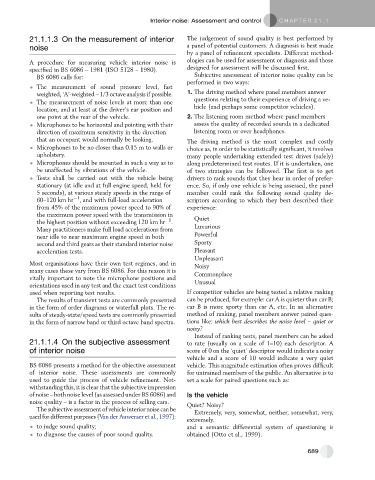Page 678 - Automotive Engineering Powertrain Chassis System and Vehicle Body
P. 678
Interior noise: Assessment and control C HAPTER 21.1
21.1.1.3 On the measurement of interior The judgement of sound quality is best performed by
noise a panel of potential customers. A diagnosis is best made
by a panel of refinement specialists. Different method-
A procedure for measuring vehicle interior noise is ologies can be used for assessment or diagnosis and those
specified in BS 6086 – 1981 (ISO 5128 – 1980). designed for assessment will be discussed first.
BS 6086 calls for: Subjective assessment of interior noise quality can be
performed in two ways:
The measurement of sound pressure level, fast
weighted, ‘A’-weighted – 1/3 octave analysis if possible. 1. The driving method where panel members answer
The measurement of noise levels at more than one questions relating to their experience of driving a ve-
location, and at least at the driver’s ear position and hicle (and perhaps some competitor vehicles).
one point at the rear of the vehicle. 2. The listening room method where panel members
Microphones to be horizontal and pointing with their assess the quality of recorded sounds in a dedicated
direction of maximum sensitivity in the direction listening room or over headphones.
that an occupant would normally be looking. The driving method is the most complex and costly
Microphones to be no closer than 0.15 m to walls or choice as, in order to be statistically significant, it involves
upholstery. many people undertaking extended test drives (safely)
Microphones should be mounted in such a way as to along predetermined test routes. If it is undertaken, one
be unaffected by vibrations of the vehicle. of two strategies can be followed. The first is to get
Tests shall be carried out with the vehicle being drivers to rank sounds that they hear in order of prefer-
stationary (at idle and at full engine speed, held for ence. So, if only one vehicle is being assessed, the panel
5 seconds), at various steady speeds in the range of member could rank the following sound quality de-
1
60–120 km hr , and with full-load acceleration scriptors according to which they best described their
from 45% of the maximum power speed to 90% of experience:
the maximum power speed with the transmission in
1
the highest position without exceeding 120 km hr . Quiet
Many practitioners make full load accelerations from Luxurious
near idle to near maximum engine speed in both Powerful
second and third gears as their standard interior noise Sporty
acceleration tests. Pleasant
Unpleasant
Most organisations have their own test regimes, and in Noisy
many cases these vary from BS 6086. For this reason it is Commonplace
vitally important to note the microphone positions and Unusual
orientations used in any test and the exact test conditions
used when reporting test results. If competitor vehicles are being tested a relative ranking
The results of transient tests are commonly presented can be produced, for example: car A is quieter than car B;
in the form of order diagrams or waterfall plots. The re- car B is more sporty than car A, etc. In an alternative
sults of steady-state/speed tests are commonly presented method of ranking, panel members answer paired ques-
in the form of narrow band or third octave band spectra. tions like: which best describes the noise level – quiet or
noisy?
Instead of ranking tests, panel members can be asked
21.1.1.4 On the subjective assessment to rate (usually on a scale of 1–10) each descriptor. A
of interior noise score of 0 on the ‘quiet’ descriptor would indicate a noisy
vehicle and a score of 10 would indicate a very quiet
BS 6086 presents a method for the objective assessment vehicle. This magnitude estimation often proves difficult
of interior noise. These assessments are commonly for untrained members of the public. An alternative is to
used to guide the process of vehicle refinement. Not- set a scale for paired questions such as:
withstanding this, it is clear that the subjective impression
of noise – both noise level (as assessed under BS 6086) and Is the vehicle
noise quality – is a factor in the process of selling cars. Quiet? Noisy?
The subjective assessment of vehicle interior noise can be Extremely, very, somewhat, neither, somewhat, very,
used for different purposes (Van der Auweraer et al., 1997):
extremely.
to judge sound quality; and a semantic differential system of questioning is
to diagnose the causes of poor sound quality. obtained (Otto et al., 1999).
689

